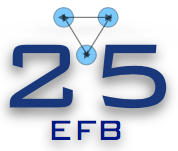Speaker
Description
In the no-core shell model, the Jacobi coordinates are often used to describe few-body systems [1]. These coordinates are convenient as they allow the explicit removal of a center of mass coordinate satisfying the requirement of translational invariance within the model space. For the description of the nucleus, the intrinsic coordinates are more natural, as it is independent of the external fields and the interactions between the nucleons depend only on the relative coordinates.
Another important requirement for the model space is the antisymmetry of the state vectors. The antisymmetry of the model space can be ensured using the Slater determinants. However, this approach is unsuitable for the Jacobi coordinates due to the complexity of the expressions for symmetric group permutation operators. To address this, you can employ the symmetric group algebra to find the antisymmetric model space. The symmetric group algebra for the few body systems is simple, but the situation differs for larger nuclei.
To overcome these challenges, we employ the so-called Λ operators [2]. We construct these operators using the two-particle transposition operators of the appropriate symmetric group, taking into account the number of nucleons in the system. We construct the representations of these operators on a Harmonic Oscillator basis. The required representations of the transformations of the Jacobi coordinates are complicated and to solve this we introduce the algebraic approach for small systems.
This project has received funding from the Research Council of Lithuania (LMTLT), agreement No S-PD-22-9
[1] S. Liebig et al., Eur. Phys. J. A 52 (2016) 103.
[2] S. Mickevičius et al., Phys. Atom. Nucl. 81 (2018) 899.

